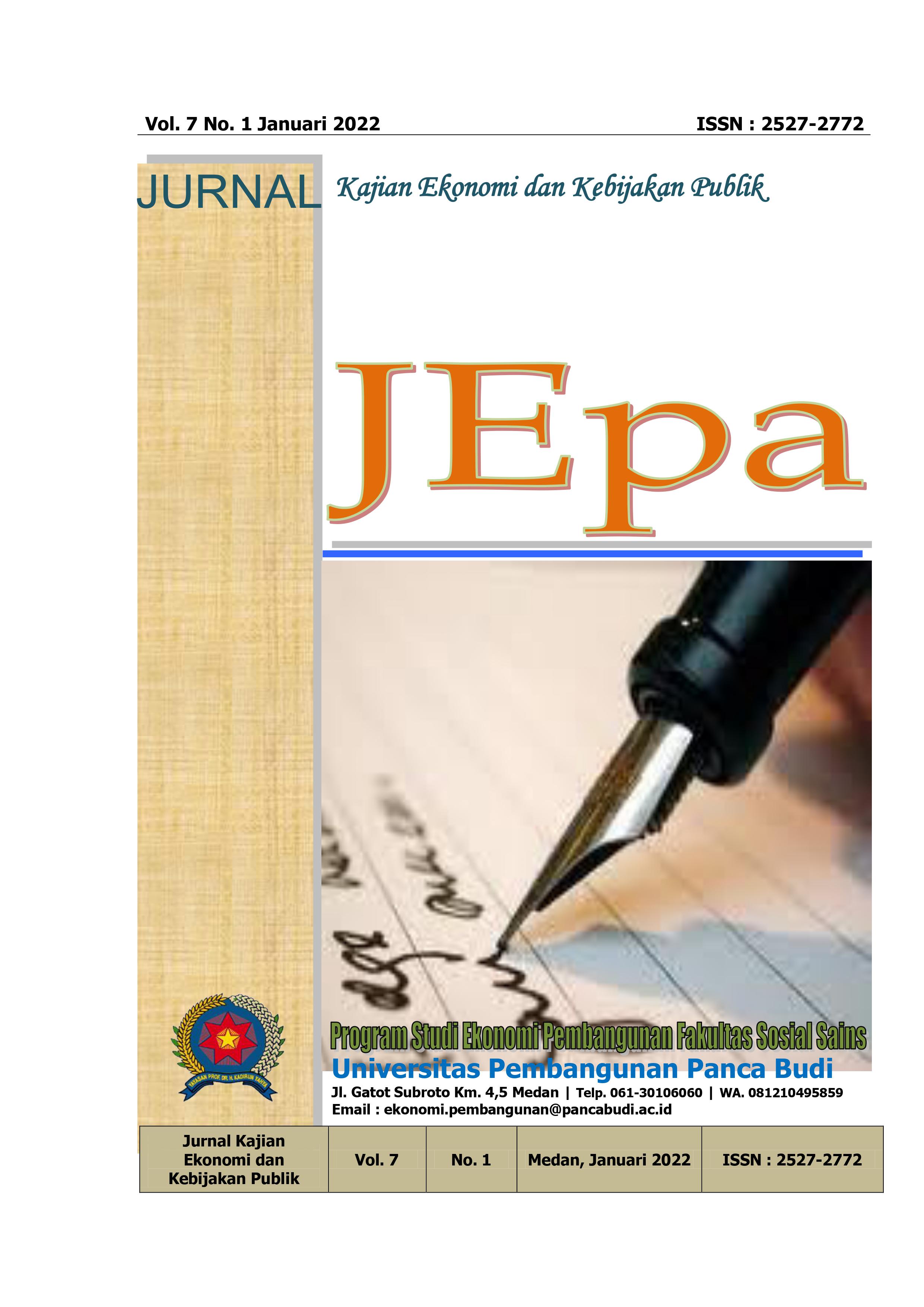DISEQUILIBRIUM PENDAPATAN DAN INDEKS INKLUSI KEUANGAN DAERAH PROVINSI DI SUMATERA PASCA COVID-19: SKENARIO BANK UMUM SYARIAH
Abstract
This paper explains the inequality of income and Sumatra regional financial inclusion index in Islamic banks post-COVID-19. This study measure, analyze and map the Financial Inclusion Index (FII) in Islamic bank by index determining in each province in Sumatra with estimating the effectiveness of financial inclusion strategies in Islamic banks to reduce income inequality in Sumatra by calculating of Human Development Index (HDI), Gender-related Development Index (GDI), Human Poverty Index (HPI), and the Availability of Banking Service (ABS) and Usability of Banking Services (UBS) dimension. Policymakers can use this measurement to observe Islamic financial contribution to reduce the income inequality as a National Economic Recovery Program and restore the conditions of priority segments of financial inclusion affected by the pandemic. The results indicated the value of FII in Islamic banks in Sumatra was low and not evenly distributed. Cross-correlation analysis showed a positive correlation between the financial inclusion index and the Gini index. This means the inequality of income contributes to the low value of FII. And the determinant of increasing inequality in the region of Sumatra is the limited access to the financial sector, especially for low-income households. This study recommends policymakers observe poverty alleviation programs, such as establishing a formal zakat department and opening Islamic bank branches at the regional level, which are expected to stabilize the financial system and encourage national economic recovery.
References
Akimov, Alexander, Albert Wijeweera, and Brian Dollery. (2016). “Finance-Growth Nexus: Evidence from Transition Economies B.
Beck, T., Demirguc-Kunt, A., and Martinez Peria, M. S. (2017). Reaching out: Access to and use of banking services across countries. Journal of Financial Economics 85, 234-266.
Berg, Andrew, and Jonathan Ostry. (2011). Inequality and Unsustainable Growth: Two Sides of the Same Coin?. International Monetary Fund Staff Discussion Note, 1–21.
Berg, Andrew, Jonathan D. Ostry, and Jeromin Zettelmeyer. (2012). What Makes Growth Sustained?. Journal of Development Economics 98(2), 149–66.
Carbo S., Gardener E.P., and Molyneux P. (2015). Financial Exclusion. Palgrave MacMillan.
Dabla-norris, Era, and Kalpana Kochhar. (2015). Causes and Consequences of Income Inequality : A Global Perspective.
Dadzie, Christabel, Luisa Blanco, and Coline Dony. (2014). Study on Crime and Investment in Latin America and the Caribbean.
Diniz, E., Birochi, R. and Pozzebon, M. (2011). Triggers and barriers to financial inclusion: The use of ICT-based branchless banking in an Amazon county. Electronic Commerce Research and Applications.
Fajnzylber, Pablo. (2012). Inequality and Violence of Crime. XLV.
Honohan, P. (2018). Cross-Country Variation in Household Access to Financial Services. Journal of Banking and Finance 32, 2493-2500
Ismail, Perbankan Syariah. (2018) Jakarta: Kencana Prenada Media Group.
Iqbal, Zamir dan Abbas Mirakhor. (2013). Pengantar Keuangan Islam Teori dan Praktik, Jakarta: Kencana.
Kammer, Alfred et al. (2015). Islamic Finance : Opportunities, Challenges, and Policy Options. Islamic finance, 1–38.
Kempson E, A. Atkinson and O. Pilley. (2014). Policy level response to financial exclusion in developed economies: lessons for developing countries. Report of Personal Finance Research Centre, University of Bristol.
Kenourgios, Dimitris, and Aristeidis Samitas. (2017). Financial Development and Economic Growth in a Transition Economy: Evidence for Poland. (1).
Kumhof, Michael, and Romain Rancière. (2013). Leveraging Inequality. Finance and Development 47(4), 28–31.
Levine, Ross. (2013). More on Finance and Growth: More Finance, More Growth?. Federal Reserve Bank of St. Louis Review 85(4), 31–46.
Levitt, Steven D. (2014). The Changing Relationship between Income and Crime Victimization. 87–98.
Leyshon, A. and Thrift N. (2011). Geographies of Financial Inclusion: Financial Abandonment in Britain and The United States. Transactions of the Institute of British Geographers. Spectrum, Journal of Political Science International Relations, Vol. 8, No.1.
Mohieldin, Mahmoud, Zamir Iqbal, Ahmed Rostom, and Xiaochen Fu. (2012). The Role of Islamic Finance in Enhancing Financial Inclusion in Organization of Islamic Cooperation (OIC) Countries. Islamic Economic Studies 20, 55–120.
Ostry, Jonathan D, Andrew Berg, and Charalambos G Tsangarides. (2014). Redistribution , Inequality , and Growth.
Park, Chan-young, and Rogelio V Mercado. (2015). Financial Inclusion , Poverty , And Income InequalIty In Developing Asia. Economics Working Paper Series. Economics Working Paper Series (426).
Park, Donghyun, and Kwangho Shin. (2015). Economic Growth, Financial Development and Income Inequality. Economics Working Paper Series. (441).
Pshisva, Rony, and Gustavo A Suarez. (2011). Capital Crimes Kidnappings and Corporate Investment in Colombia.
Rangarajan Committee (2018). Report of the Committee on Financial Inclusion. Government of India.
Sarma, Mandira. (2012). Index of Financial Inclusion. CITD Discussion Paper 10-05.
Stolzenberg, Lisa, David Eitle, and Stewart J D Alessio. (2016). Race , Economic Inequality, and Violent Crime. 34: 303–16.
Seidman, E., Hababou, M. and Kramer, J. (2015). Getting to Know Underbanked Consumers: A Financial Services Analysis. Report of the Center for Financial Services Innovation, Chicago.
Sinclair S. P. (2011). Financial exclusion: An introductory survey. Report of Centre for Research in Socially Inclusive Services, Heriot-Watt University, Edinburgh.
Tambunan. Tulus. T. H. (2011). Perekonomian Indonesia: Kajian Teoritis dan Analisis Empiris. Bogor: Ghalia Indonesia.
UNDP. (2019). Human Development Report 2019. United Nations Development Programme. Yorulmaz, Recep. (2013). Construction of a Regional Financial Inclusion Index in Turkey: 79–101.




